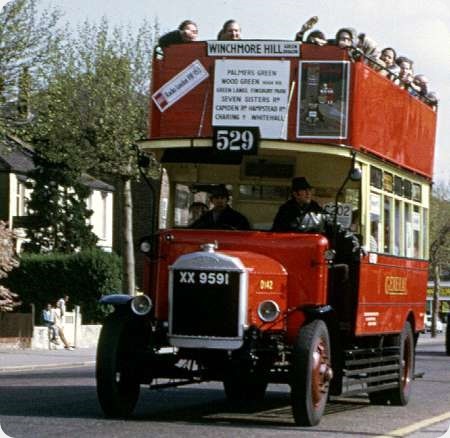London General – Dennis 4 ton – XX 9591 – D 142
London General Omnibus Company
1925
Dennis 4 ton
Dodson O26/22RO
Pictured at South Croydon on the May 1972 HCVC London – Brighton rally is Dennis 4 ton XX 9591, D142 of 1925 with the almost inevitable Dodson O26/22RO bodywork. This bus has a complicated history that is detailed on the London Bus Museum website
Although a service was run by Charles Waymann in the Waltham Abbey area from 1920 to 1926, initially using a single decker and a double decker, both of the B type, and a Straker Squire double decker, the first “Pirate” bus in central London is generally credited as being the Leyland operated by Arthur George Partridge, which took to the road on 5 August 1922 under the trading name “Chocolate Express” (though only "Express" appeared on the body sides). The vehicle was a Leyland LB1 (i.e London Bus), a straight chassis vehicle developed from the heavier standard G7 model specifically to meet the stringent Metropolitan Police design requirements. There followed a flurry of activity in 1922 as other opportunist entrepreneurs entered the fray using a great variety of vehicle makes, but the Independents’ choice of double decker manufacture soon generally settled down to that between the Leyland LB (developed as the LB2, then LB4 and finally LB5) and the equally sturdy Dennis 4 tonner. The Dennis was a straight framed haulage chassis derived from the wartime “Subvention” or “Subsidy” type, of which over 7000 were produced in various wheelbases and weights between 1914 and 1918. A few single deck Dennis buses appeared on the London scene in 1922, but, to gain proper access to the lucrative London market, Dennis sought the acceptance of the 4 tonner by the Metropolitan Police as a passenger carrying double decker. Accordingly, the bus variant of the 4 ton model was modified for London in 1923 and emerged with the following specifications:-
Wheelbase extended from 15ft 6ins to 15ft 10ins
Larger front wheels from 720mm to 850mm
Cone clutch, four speed sliding mesh gearbox, overhead worm rear axle (contemporary LGOC buses had 3 speed chain gearboxes – it would seem that, even way back then, AEC spur gearboxes were noisy and unacceptable to the Met).
Body O26/22RO
CAV lighting set
The first 4 tonner for London operation was reported in Commercial Motor in August 1923 as being destined for Messrs W.H. Collins and Co. trading as A1 and painted chocolate brown. The engine, described below, was supplied by the White and Poppe factory in Coventry, set up in 1899 by Alfred White and Peter Poppe (pronounced ‘Popper’ – he was a Norwegian). This company became the main supplier of engines to Dennis who went on to purchase the Coventry firm in the post war recession of 1919.
‘T’ head side valve, 4 cylinder
115mm x 150mm = 6.232 litre, 40 -50 bhp
This engine, stated in the 1923 report as being the power plant of the 4 ton bus, was a widely used and successful unit, 4591 examples being made up to the Dennis takeover in 1919, and it then continued in volume production until the late 1920s. This was certainly the standard engine of the 4 ton double decker. A modified version uprated to 70 bhp was fitted to Dennis’s first bespoke bus chassis, the E type of 1925.
Now comes the conundrum. The power unit of D142 is stated on sundry preservation pages to be an example of the Type D, with a capacity of 5.8 litres yielding 36 bhp. However, the Type D engine (derived from its precursor, the Type C manufactured from 1913) is listed in Dennis drawings as:-
‘L’ head side valve, 4 cylinder
110mm x 150 mm = 5.702 litre, 44 bhp
Thus the alleged engine type of D142 is not consistent with the claimed capacity. The nearest White and Poppe engine of 5.8 litres was this 4 cylinder side valve, very unusual in a time of long stroke engines in being almost "square", and thus probably intended for private car applications:-
120mm x 130mm = 5.881 litre, 40-50 bhp, but only 209 of this engine version were made before the Dennis takeover in 1919, and it does not appear in the Dennis list of engine drawings from that date, which indicates that it was not produced later. Unless the preserved vehicle has improbably received a very rare earlier type of White and Poppe engine, which is emphatically not the alleged Type D anyway, the 5.8 litre engine description must be considered doubtful. I believe the engine in D142 to be the standard 6.232 litre unit approved by the Metropolitan Police, but comments would be welcome.
Photograph and Copy contributed by Roger Cox
Quick links to the - Comments Page - Contact Page - Home Page
Comments - Please note: The comments facility is not currently available. Please see the home page for updates.
Please Note if you want to send a photograph with your comment please use the Contact Page by clicking here or send as an attachment via email.

